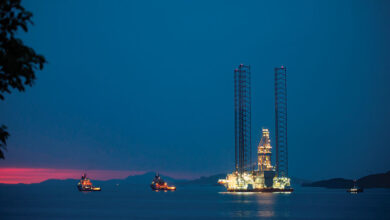API RP 2SK: Stationkeeping: an emerging practice for moored MODUs in GOM hurricanes
By David Petruska, GoM SPU Riser Technical Authority, BP America
Mobile Offshore Drilling Units (MODUs) in the Gulf of Mexico are a critical part of the infrastructure required for oil and gas E&P. Industry standards that allow safe and economic operations are important to the industry, community and regulatory authorities. Much work has been done since the events of the 2004 and 2005 hurricane seasons to better understand the causes of moored MODU failures and learn from them. This knowledge has resulted in changes to the industry standards.
API RP 2SK 3rd Edition establishes a minimum acceptable design code for mooring systems. RP 2SK requires a mobile mooring, like that on a MODU, be designed to a 5-year return period event when operating away from other structures. When operating in the vicinity of other structures, a 10-year return period event is required. However, no specific definitions are provided on what is considered “away from” and “in the vicinity of.” Some examples are given for operations in the vicinity of other structures. RP 2SK also permits using a risk analysis to determine the design return period, but in no case shall it be less than one year.
Three strong hurricanes (Ivan, Katrina and Rita) entering the Gulf of Mexico within roughly a 12-month period and carving paths through areas of the Gulf of
Mexico with extensive oilfield infrastructure was unprecedented. In the past, hurricanes have caused MODU mooring failures; for example, in Andrew and Lili. However, over time, the number of MODUs working in the deep water has increased, along with more infrastructure, thus increasing the probability of failure and possible consequences of failure (damage).
New criteria, which are risk based, are needed to better protect critical infrastructure during GoM hurricanes unless a more prescriptive type of code can be developed. The industry’s initial response to the problem was addressed in API RP 95F, 1st Edition, published in May 2006. The minimum design return period was increased to a 10-year return period event, whether far from or in the vicinity of infrastructure. It also required the use of the Central Gulf metocean criteria developed by the ABSC MODU Mooring JIP or site-specific criteria, which includes the 2004 and 2005 hurricane season hindcast. Also, in no case is the one-minute wind speed to be less than 64 knots (a threshold category 1 hurricane). 95F also recommends that a site-specific assessment be conducted to evaluate the risk of such operations during hurricane season.
For the 2007 hurricane season, a 2nd Edition of 95F was released that was an improvement over the 1st Edition but still did not provide all the guidance needed by the industry. The 2nd Edition included guidance on post-storm inspection and recertification of mooring components to ensure the integrity of components from a damaged mooring system. This guidance was subsequently incorporated in API RP 2I, 2nd Edition, mooring inspection, which was successfully balloted by API Subcommittee 2 in spring 2007. RP 2I also dictates that mooring components should go through a more thorough and fully documented quality and inspection process.
A risk-based approach has been developed and incorporated into a new Appendix K of RP 2SK to replace 95F for the 2008 hurricane season and beyond. Proper implementation of the appendix will aid in the planning of drilling operations and the designs of MODU mooring systems, which should reduce the consequences to the MODU fleet and offshore infrastructure if the 2004-05 hurricane seasons repeat.
In parallel with the efforts of the 2SK Task Group, a joint industry project was launched to explicitly study and learn from the successes and failures of moored MODUs during the 2004-05 hurricane seasons. The JIP and the 2SK Task Group worked closely together to mutually benefit from each other’s efforts. A key objective of the JIP was to pass on results from studies that could benefit the 2SK Task Group in developing the Commentary. Explicit studies that were conducted and how they benefited the 2SK Task Group will be discussed and how they impacted the 2SK Commentary. This includes development of a consequence-based assessment spreadsheet tool, a mooring reliability study, fleet mooring capability for the original and upgraded mooring systems and comparative risk assessment.
Industry response to the impact of the hurricanes and the evolving practices shows the commitment by all to address and correct this issue. Even before 95F 1st Edition was published, MODU owners had begun making significant upgrades to the mooring systems. Use of additional mooring lines, “rig upgrades,” and use of alternative mooring systems and components, “component upgrades” have become more common in an effort to reduce the probability of a MODU failure or the likelihood of damage to surrounding infrastructure should a failure occur.
For more information, please see OTC 19607, “API RP 2SK: Stationkeeping – An Emerging Practice,” and API RP 2SK, Appendix K, Gulf of Mexico MODU Mooring Practice For Hurricane Season. David Petruska is GoM SPU Riser Technical Authority for BP America and chairman of the API Stationkeeping Task Groups.




